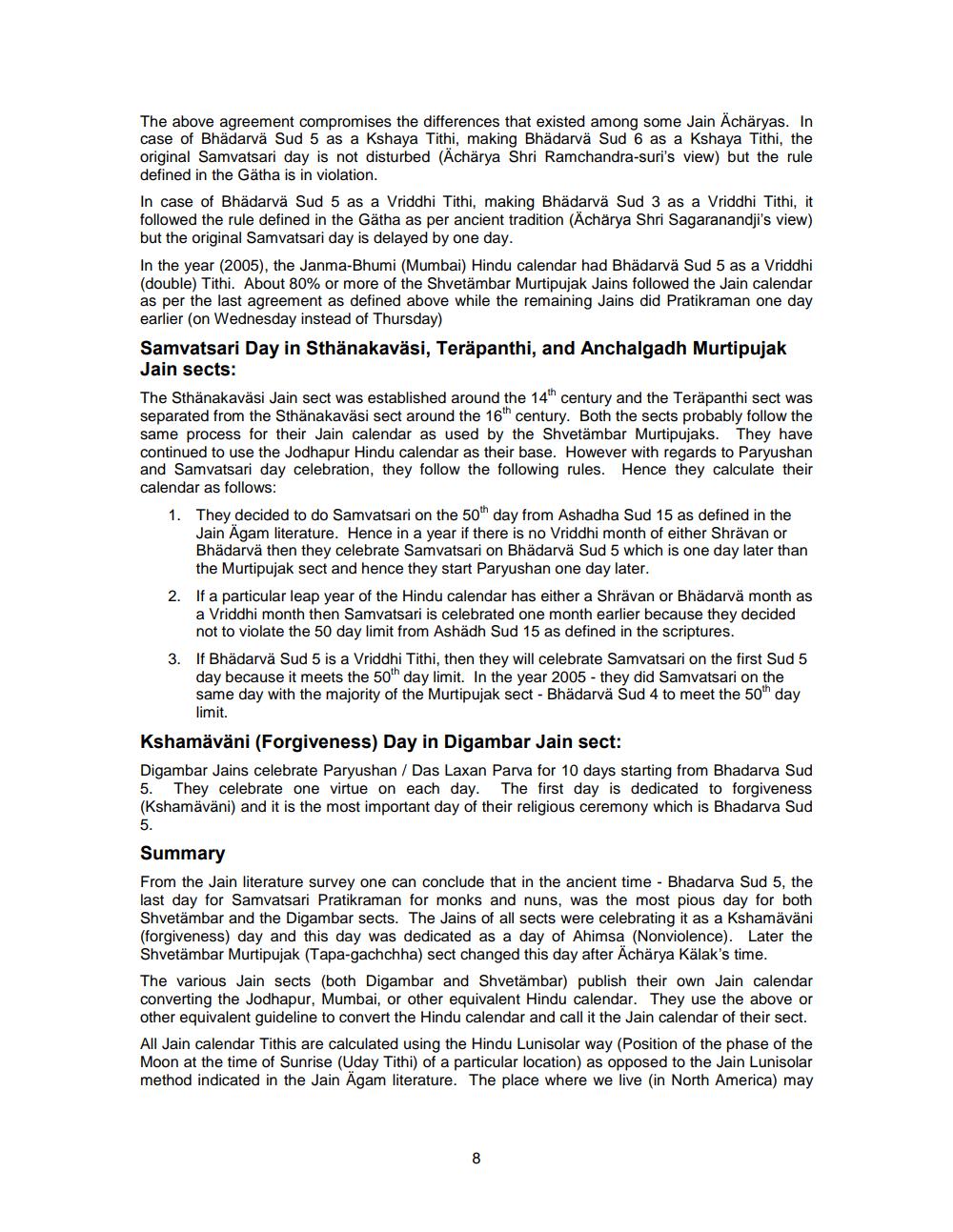Book Title: Historical Perspective of Samvatsari Day and Jain Calendar Author(s): Pravin K Shah Publisher: JAINA Education Committee View full book textPage 8
________________ The above agreement compromises the differences that existed among some Jain Acharyas. In case of Bhädarvä Sud 5 as a Kshaya Tithi, making Bhädarvä Sud 6 as a Kshaya Tithi, the original Samvatsari day is not disturbed (Acharya Shri Ramchandra-suri's view) but the rule defined in the Gatha is in violation. In case of Bhädarvä Sud 5 as a Vriddhi Tithi, making Bhädarvä Sud 3 as a Vriddhi Tithi, it followed the rule defined in the Gatha as per ancient tradition Acharya Shri Sagaranandji's view) but the original Samvatsari day is delayed by one day. In the year (2005), the Janma-Bhumi (Mumbai) Hindu calendar had Bhädarvä Sud 5 as a Vriddhi (double) Tithi. About 80% or more of the Shvetämbar Murtipujak Jains followed the Jain calendar as per the last agreement as defined above while the remaining Jains did Pratikraman one day earlier (on Wednesday instead of Thursday) Samvatsari Day in Sthänakaväsi, Teräpanthi, and Anchalgadh Murtipujak Jain sects: The Sthänakaväsi Jain sect was established around the 14" century and the Teräpanthi sect was separated from the Sthänakaväsi sect around the 16th century. Both the sects probably follow the same process for their Jain calendar as used by the Shvetämbar Murtipujaks. They have continued to use the Jodhapur Hindu calendar as their base. However with regards to Paryushan and Samvatsari day celebration, they follow the following rules. Hence they calculate their calendar as follows: 1. They decided to do Samvatsari on the 50th day from Ashadha Sud 15 as defined in the Jain Agam literature. Hence in a year if there is no Vriddhi month of either Shrävan or Bhädarvä then they celebrate Samvatsari on Bhädarvä Sud 5 which is one day later than the Murtipujak sect and hence they start Paryushan one day later. 2. If a particular leap year of the Hindu calendar has either a Shrävan or Bhädarvä month as a Vriddhi month then Samvatsari is celebrated one month earlier because they decided not to violate the 50 day limit from Ashädh Sud 15 as defined in the scriptures. 3. If Bhädarvä Sud 5 is a Vriddhi Tithi, then they will celebrate Samvatsari on the first Sud 5 day because it meets the 50" day limit. In the year 2005 - they did Samvatsari on the same day with the majority of the Murtipujak sect - Bhädarvä Sud 4 to meet the 50 day limit. Kshamäväni (Forgiveness) Day in Digambar Jain sect: Digambar Jains celebrate Paryushan / Das Laxan Parva for 10 days starting from Bhadarva Sud 5. They celebrate one virtue on each day. The first day is dedicated to forgiveness (Kshamäväni) and it is the most important day of their religious ceremony which is Bhadarva Sud Summary From the Jain literature survey one can conclude that in the ancient time - Bhadarva Sud 5, the last day for Samvatsari Pratikraman for monks and nuns, was the most pious day for both Shvetämbar and the Digambar sects. The Jains of all sects were celebrating it as a Kshamäväni (forgiveness) day and this day was dedicated as a day of Ahimsa (Nonviolence). Later the Shvetämbar Murtipujak (Tapa-gachchha) sect changed this day after Acharya Kälak's time. The various Jain sects (both Digambar and Shvetämbar) publish their own Jain calendar converting the Jodhapur, Mumbai, or other equivalent Hindu calendar. They use the above or other equivalent guideline to convert the Hindu calendar and call it the Jain calendar of their sect. All Jain calendar Tithis are calculated using the Hindu Lunisolar way (Position of the phase of the Moon at the time of Sunrise (Uday Tithi) of a particular location) as opposed to the Jain Lunisolar method indicated in the Jain Agam literature. The place where we live in North America) mayPage Navigation
1 ... 6 7 8 9 10 11
